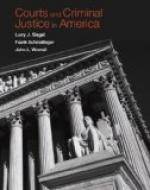Clever counsel, of course, habitually make use of all sorts of appeals to sympathy and prejudice. In one case in New York in which James W. Osborne appeared as prosecutor the defendant wore a G.A.R. button. His lawyer managed to get a veteran on the jury. Mr. Osborne is a native of North Carolina. The defendant’s counsel, to use his own words, “worked the war for all it was worth,” and the defendant lived, bled and died for his country and over and over again. In summing up the case, the attorney addressed himself particularly to the veteran on the back row, and, after referring to numerous imaginary engagements, exclaimed: “Why, gentlemen, my client was pouring out his life blood upon the field of battle when the ancestors of Mr. Osborne were raising their hands against the flag!” For once Mr. Osborne had no adequate words to reply.
By far the most effective and dangerous “trick”
employed by guilty defendants is the deliberate shouldering
of the entire blame by one of two persons who are
indicted together for a single offence. A common
example of this is where two men are caught at the
same time bearing away between them the spoil of their
crime and are jointly indicted for “criminally
receiving stolen property.” Both, probably,
are “side partners,” equally guilty, and
have burglarized some house or store in each other’s
company. They maybe old pals and often have
served time together. They agree to demand separate
trials, and that whoever is convicted first shall
assume the entire responsibility. Accordingly,
A. is tried and, in spite of his asseveration that
he is innocent and that the “stuff” was
given him by a strange man, who paid him a dollar to
transport it to a certain place, is properly convicted.*
The bargain holds. B.’s case is moved
for trial and he claims never to have seen A. in his
life before the night in question, and that he volunteered
to help the latter carry a bundle which seemed to
be too heavy for him. He calls A., who testifies
that this is so—that B., whom he did not
know from Adam, tendered his services and that he
availed himself of the offer. The jury are usually
prone to acquit, as the weight of evidence is clearly
with the defendant.
_______________________________________
* The defence that the accused innocently received the stolen property into his possession was a familiar one even in 1697, as appears by the following record taken from the Minutes of the Sessions. It would seem that it was even then received with some incredulity.
City & county of new York: ss:
At a Meeting of the Justices of the Peace for the said City & County at the City Hall of the said City on Thursday the 10th day of June Anno Dom 1697.
Present.
William
Morrott \ Esquires
James
Graham / quorum




